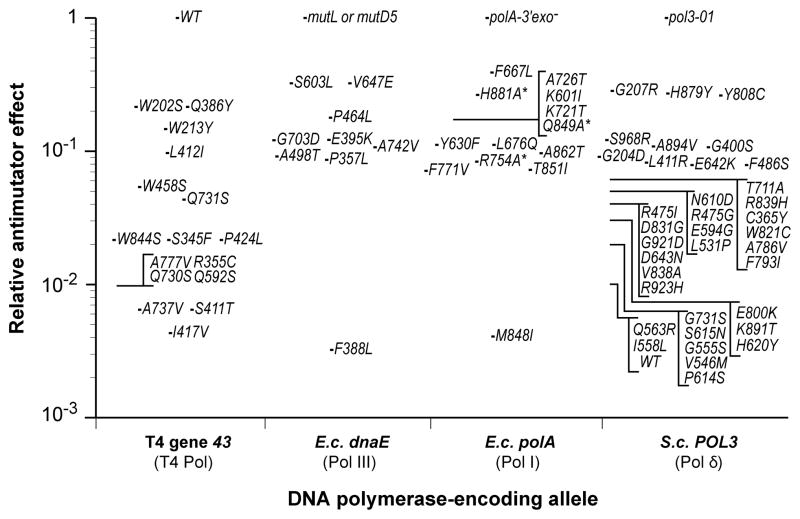Figure 2.
Antimutator effects of DNA polymerase variants. The relative mutation frequency or rate conferred by T4 Pol, E. coli Pol III and Pol I, and yeast Pol δ antimutator variants are shown. Each variant is indicated by the single amino-acid substitution that confers antimutator activity. The T4 Pol antimutator effects are based on reversion frequency of rII UV199oc relative to wild-type T4 Pol (Reha-Krantz, 1988; Reha-Krantz and Nonay, 1993; Reha-Krantz and Nonay, 1994; Reha-Krantz and Wong, 1996). The value for the S411T single mutant is inferred from the reversion frequency of the S411T, L412M double mutant (Reha-Krantz and Nonay, 1993). Pol III antimutator effects are based on the average degree of mutL and/or mutD5 mutator suppression, as measured by the frequency of Rifampicin-resistance, Nalidixic acid-resistance, GalK2 (ochre) reversion and/or lacZ118 (ochre) reversion (Fijalkowska et al., 1993; Fijalkowska and Schaaper, 1993; Fijalkowska and Schaaper, 1995; Fijalkowska and Schaaper, 1996). The average background reversion frequency for WT cells is reported to be 3 × 10−4 relative to mutD5 (Schaaper, 1988). All Pol I antimutators were engineered into an E. coli Pol I variant lacking proofreading capability (D424A), with the exception of the Taq Pol I antimutator F667L (Suzuki et al., 2000). The relative antimutator activities of Pol I variants marked with an asterisk are based on in vitro gap-filling mutation rate determinations (Minnick et al., 1999). All other Pol I values are based on reversion frequencies of a premature nonsense codon in a plasmid-borne β-lactamase gene (Suzuki et al., 2000; Shinkai and Loeb, 2001; Shinkai et al., 2001; Loh et al., 2007). The effect of Pol δ antimutators are based on suppression of the proofreading-defective pol3-01 mutator allele, as measured by the rate of FOA-resistance mutations (Herr et al., 2011).

